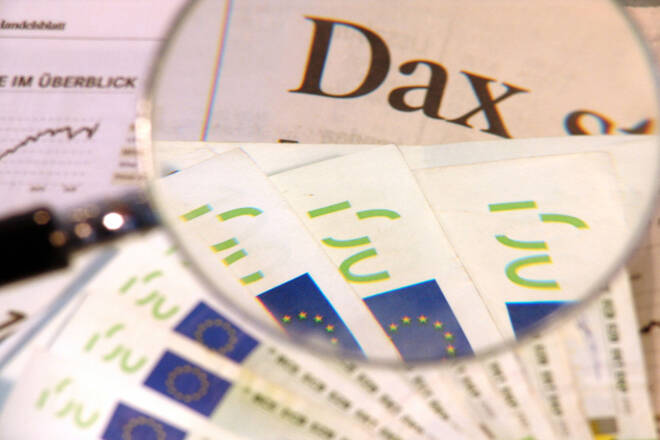Advertisement
Advertisement
Dax Index and the Bearish Shift: Navigating Dax Stocks Amid Global Uncertainty
By:
As China's economic data sets the tone for Dax stocks, all eyes are on Germany's ZEW Economic Sentiment figures, forecasted to decline further.
Highlights
- The DAX closed at 15,904, with ADNOC’s potential bid for Covestro offering a market boost.
- US equity markets rallied late in the European session, contributing to the bullish session.
- Today, German ZEW sentiment is expected to decline further.
It was a choppy but bullish start to the week for the DAX. On Monday, the DAX gained 0.46%. Partially reversing a 1.03% loss from Friday, the DAX ended the day at 15,904.
There were no economic indicators from China or the US to influence investor sentiment. Investor angst over China’s troubles and German wholesale price numbers for July weighed on investor sentiment. However, news of ADNOC considering upping its bid to acquire Covestro (+3.8%) provided support.
Late in the European session, the US equity markets made gains, contributing to the bullish session.
The NASDAQ Composite rose by 1.05% on Monday. It was also a bullish session for the Dow and the S&P 500, which saw gains of 0.07% and 0.57%, respectively.
German Wholesale Prices Failed to Impress
German wholesale inflation figures provided little comfort. In July, the German wholesale price index fell by 2.8% year-over-year versus a forecasted 2.6% decline. Wholesale prices declined by 2.9% in June.
While the wholesale price index fell just 0.2% in July, month-on-month, the figures reflected a weak demand environment.
There were no US economic indicators for investors to consider.
The Market Movers
It was a mixed session for the auto sector. Continental AG and BMW saw gains of 0.54% and 0.11%, respectively. However, Porsche fell by 0.71%, with Mercedes-Benz Group and Volkswagen ending the day down 0.39% and 0.09%, respectively. Investor angst over China and the latest wholesale prices delivered a mixed session. Continental was among the worst performers.
Exposure to China will continue to pressure autos.
It was also a mixed session for the banks. Commerzbank declined by 1.36%, while Deutsche Bank gained 0.35%. There were news events to send Commerzbank south, with recessionary fears likely weighing as the bank struggles with bad loans.
The Day Ahead for the DAX
Economic data from China will set the tone.
Industrial production increased 3.7% year-over-year in July versus 4.4% in June, with retail sales up 2.5% versus 3.1% in June. Economists forecast increases of 4.5% and 4.8%, respectively.
Other indicators were also bearish. The unemployment rate increased from 5.2% to 5.3%, with fixed asset investments rising by 3.4% versus 3.8% in June. Economists forecast fixed asset investments to be up 3.8%.
However, news of the PBoC cutting key policy rates offset the negative numbers.
Later today, ZEW Economic Sentiment figures for Germany and the Eurozone will draw interest. The macroeconomic environment has deteriorated, suggesting a sharp decline in sentiment. Economists forecast the German ZEW Economic Sentiment Indicator to fall from -14.7 to -16.0.
The ZEW Economic Sentiment Index reflects the level of optimism or pessimism that analysts have regarding the economic outlook over six months. Negative figures reflect a pessimistic view of the economic outlook and an increasing chance of a recession.
US retail sales and the NY Empire State Manufacturing Index will move the dial. We expect the retail sales figures to have more impact.
Economists forecast retail sales to increase by 0.4% in July versus +0.2% in June.
A jump in retail sales could force the Fed to hike rates to curb spending and eliminate the demand effect on consumer price inflation.
DAX Technical Indicators
Looking at the EMAs and the 4-hourly chart, the EMAs sent bearish signals. The DAX sat below the 50-day and 200-day EMAs, sending bearish near and longer-term price signals.
The 14-4H RSI sits at 46.93, reflecting bearish sentiment, with selling pressure overweighing buying pressure. Significantly, the RSI aligns with the EMAs, supporting a return to 15,750 to target the 15,600 – 15,525 support band.
For a look at the economic events, check out our economic calendar.
About the Author
Bob Masonauthor
With over 28 years of experience in the financial industry, Bob has worked with various global rating agencies and multinational banks. Currently he is covering currencies, commodities, alternative asset classes and global equities, focusing mostly on European and Asian markets.
Did you find this article useful?
Latest news and analysis
Advertisement
